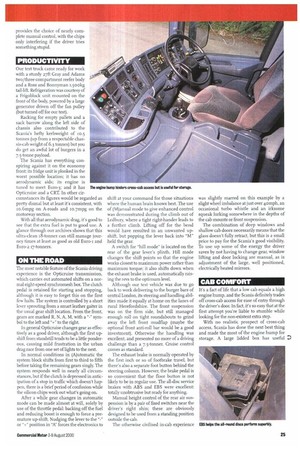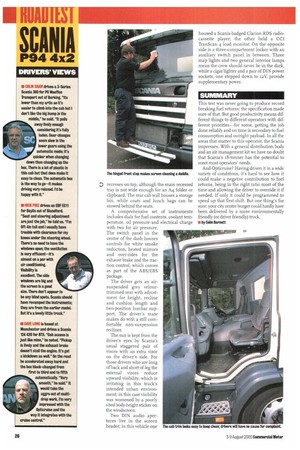Our test truck came ready for work with a sturdy
Page 27

Page 28

If you've noticed an error in this article please click here to report it so we can fix it.
27ft Gray and Adams two/three-compar iment reefer body and a Ross and Bonnyman 1,500kg tail-lift. Refrigeration was courtesy of a Frigoblock unit mounted on the front of the body, powered by a large generator driven off the fan pulley (but turned off for our test).
Racking for empty pallets and a sack barrow along the left side of chassis also contributed to the Scania's hefty kerbweight of 10.5 tonnes (up from a respectable chassis-cab weight of 6.3 tonnes) but you do get an awful lot of burgers in a 7.5-tonne payload.
The Scania has everything conspiring against it on the economy front its fridge unit is plonked in the worst possible location; it has no aerodynamic aids; its engine is tuned to meet Euro-3; and it has Opticruise and a CRT. In other circumstances its figures would be regarded as pretty dismal but at least it's consistent, with ro.6mpg on A-roads and io.7mpg on the motorway section.
With all that aerodynamic drag, it's good to see that the extra fuel is put to good use. A glance through our archives shows that this ultra-clean r8-tonner can still manage journey times at least as good as old Euro-r and Euro-2 17-tonners.
ON THE ROAD
The most notable feature of the Scania driving experience is the Opticruise transmission, which carries out automated shifts on a normal eight-speed synchromesh box. The clutch pedal is retained for starting and stopping, although it is easy to forget this on the first few halts. The system is controlled by a short lever sprouting from a smart leather gaiter in the usual gear shift location. From the front, gears are marked R, N, A, M, with a "-" symbol to the left and "+" to the right.
In general Opticruise changes gear as effectively as a good driver, although the first upshift from standstill tends to be a little ponderous, causing mild frustration in the urban drag race from one set of lights to the next.
In normal conditions in (A)utomatic the system block shifts from first to third to fifth before taking the remaining gears singly. The system responds well in nearly all circumstances, but if the clutch is depressed in anticipation of a stop in traffic which doesn't happen, there is a brief period of confusion while the silicon chips work out what's going on.
After a while gear .changes in automatic mode can be made almost at will, solely by use of the throttle pedal: backing off the fuel and reducing boost is enough to force a premature up-shift. Nudging the lever to the or "+" position in "A" forces the electronics to shift at your command for those situations where the human brain knows best. The use of (M)anual mode to give enhanced control was demonstrated during the climb out of Ledbury, where a tight right-hander leads to a further climb. Lifting off for the bend would have resulted in an unwanted upshift, but popping the lever back into "M" held the gear.
A switch for "hill mode" is located on the rear of the gear lever's plinth. Hill mode changes the shift points so that the engine works closest to maximum power rather than maximum torque; it also shifts down when the exhaust brake is used, automatically raising the revs to the optimum level.
Although our test vehicle was due to go back to work delivering to the burger bars of central London, its steering and handling abilities made it equally at home on the lanes of rural Herefordshire. The front suspension was on the firm side, but still managed enough roll on tight roundabouts to grind away the left front mudflap (maybe the optional front anti-roll bar would be a good investment). Otherwise the handling was excellent, and presented no more of a driving challenge than a 7.5-tonner. Cruise control comes as standard.
The exhaust brake is normally operated by the first inch or so of footbrake travel, but there's also a separate foot button behind the steering column. However, the brake pedal is so convenient that the floor button is not likely to be in regular use. The all-disc service brakes with ABS and EBS were excellent: totally unobtrusive but ready for anything.
Manual height control of the rear air suspension is by a pair of fixed switches near the driver's right shin; these are obviously designed to be used from a standing position outside the cab.
The otherwise civilised in-cab experience was slightly marred on this example by a slight wheel imbalance at just over vmph, an occasional turbo whistle and an irksome squeak lurking somewhere in the depths of the cab mounts or front suspension.
The combination of deep windows and shallow cab doors necessarily means that the glass doesn't fully retract, but this is a small price to pay for the Scania's good visibility. To use up some of the energy the driver saves by not having to change gear, window lifting and door locking are manual, as is adjustment of the large, well positioned, electrically heated mirrors.
CAB COMFORT
It's a fact of life that a low cab equals a high engine hump, and the Scania definitely trades off cross-cab access for ease of entry through the driver's door. In fact, it's so easy that at the first attempt you're liable to stumble while looking for the non-existent extra step.
With no realistic prospect of cross-cab access, Scania has done the next best thing and made the most of the engine hump for storage. A large lidded box has useful P recesses on top, although the main recessed tray is not wide enough for an A4 folder or clipboard. The rear cab wall houses a storage bin, while coats and lunch bags can be stowed behind the seats.
The driver gets an airsuspended grey velourtrimmed seat with adjustment for height, recline and cushion length and two-position lumbar support. The driver's mate makes do with a still comfortable non-suspension recliner.
The sun is kept from the driver's eyes by Scania's usual staggered pair of visors with an extra visor on the driver's side. For those drivers who are long of back and short of leg the external visors reduce upward visibility, which is irritating in this truck's intended urban environment; in this case visibility was worsened by a poorly sited body-height sticker on the windscreen.
Two DIN audio apertures live in the screen header; in this vehicle one housed a Scania-badged Clarion RDS radiocassette player; the other held a CC I TranScan 4 load monitor. On the opposite side is a three-compartment locker with an auxiliary switch panel in between. Three map lights and two general interior lamps mean the crew should never be in the dark, while a cigar lighter and a pair of DIN power sockets, one stepped down to 12V, provide supplementary power.
SUMMARY
This test was never going to produce record breaking fuel returns; the specification made sure of that. But good productivity means different things to different operators with different priorities—for some, getting the job done reliably and on time is secondary to fuel consumption and outright payload. In all the areas that matter to this operator, the Scania impresses. With a general distribution body and an air management kit we have no doubt that Scania's r8-tonner has the potential to meet most operators' needs.
And Opticruise? Having driven it in a wide variety of conditions, it's hard to see how it could make a negative contribution to fuel returns, being in the right ratio most of the time and allowing the driver to override it if needed. If only it could be programmed to speed up that first shift. But one thing's for sure: your city centre burger could hardly have been delivered by a more environmentally friendly (or driver friendly) truck.
m by Coln Barnett




































































































